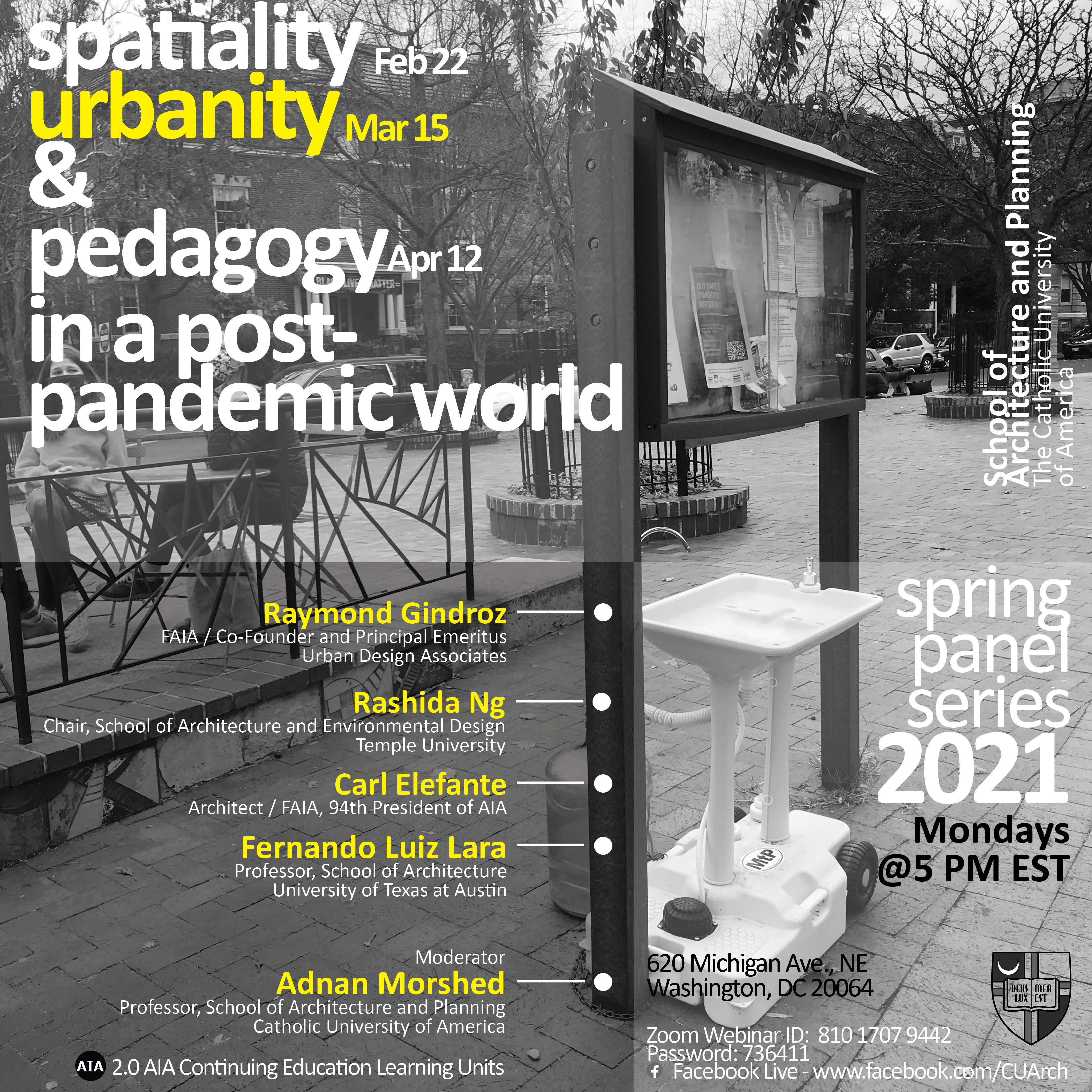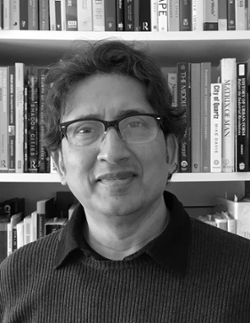
Albert Einstein once said, “The world as we have created it is a process of our thinking. It cannot be changed without changing our thinking.” How do we know when our thinking and the world it produces need to change? Does that moment arrive as part of natural cycles or because of human action? Recalling Thomas Kuhn, what is the politics of “paradigm shift” in the 21st century, particularly in the wake of a global pandemic?
These questions provide us with a framework to debate the nature of the built environment and the pedagogy it warrants in a post-pandemic world. There is little doubt that the 2020 pandemic has profoundly affected the entire world with unimaginable economic, social, public-health, urban, and environmental consequences. It has exposed, among other vulnerabilities, our weakness in disaster preparedness, our inadequacies in creating inclusive public-health infrastructures, our privileged hesitation to tackle racial, social, and gender injustice, and our misguided policies of urban governance and spatial management. The pandemic has also compelled us to question some of the fundamentals of our lives, politics, societies, and institutions. The fear of contracting Covid-19 has made us conscious of the traditional ways we use public and private spaces. Our pandemic-induced anxiety of being in public places made us suspicious of urban density and social proximity. Shifts in workplace culture are not only shrinking the city’s retail and office areas but also changing the very notions of home, office, and commuting. The pandemic has resulted in empty office spaces in many cities, provoking ideas as to how to convert offices into residential units and homes into home-office hybrids. As tourism and business travel dwindle, the future of hotel space becomes increasingly uncertain.
Should we reimagine the “disciplinary matrix” of architecture (whatever it means) to combat future pandemics, while ensuring urban equity as a foundation for socio-urban organization? What kind of city planning would prevent viral spread, while urban poverty and gender disparity are mitigated with a new generation of humanist considerations? What is, or should be, the nature of spatial and urban pedagogy in a post-pandemic world? The 13th-century Persian poet Rumi wrote: “Yesterday I was clever, so I wanted to change the world. Today I am wise, so I am changing myself.” What does it mean to be “wise” in the context of today’s politics, spatiality, and urbanity to anticipate the nature of change itself? Between 1347 and 1352, the Black Death killed nearly 40% of Europe’s population. What can we learn from the ways the Black Death catalyzed the collapse of the medieval feudal economy and signaled the advent of the Renaissance and gradually the modern world? Is it time to revisit the 19th-century public-health origins of modern architecture and urban planning in London, New York, Paris, Kolkata, and other metropolises?
As architects and urban professionals engaged in the stewardship of the built environment, we are challenged to reconsider the future of architecture, cities, and the pedagogies with which we endeavor to understand the spatial dimensions of humanity’s wellbeing. Are our building sciences adequate to address the calamities of future pandemics, economic inequity, and other social pathologies? Emboldened by an unflinching belief in technological prowess, have we forgotten the time-tested passive methods of keeping buildings healthy and economical? Are we developing our cities turning a blind eye to the systemic racial and gender injustices that plague our cities? Have we undermined the power of empathy in user-conscious space-making?
The Spring Panel Series 2021 at the Catholic University of America Architecture plans to develop a critical conversation on post-pandemic thinking on spatiality (Feb. 22), urbanity (Mar. 15), and pedagogy (APR. 12). Adnan Morshed, professor at the School of Architecture and Planning, CUA, will moderate the panels that include academics, architects, urban planners.
Meet our panelists
-
Raymond Gindroz (FAIA/ Co-Founder and Principal Emeritus Urban Design Associates)

Ray Gindroz, is a co-founder (1964) and Principal Emeritus of Urban Design Associates, an international practice of Urban Design and Architecture. He pioneered the development of participatory planning processes for neighborhoods, downtowns and regional plans. He is an internationally recognized advocate and veteran practitioner of “architecture as city-building”and led the revival Pattern Books as a means of implementing urbanism. He has taught urban design at Yale University, Carnegie Mellon University and Hampton University. He was a Senior Fellow of the Prince’s Foundation in London, Chairman of the Board of the Congress for the New Urbanism and the Seaside Institute as well as a member of several boards including the Institute for Classical Art and Architecture. . He was the principal author of “The Urban Design Handbook”(Norton), “The Architectural Pattern Book”(Norton) and The Place of Dwelling (The Princes Foundation, London).
-
Rashida Ng (Associate Professor, Tyler School of Art and Architecture, Temple University)

Ng is currently serving as past-president of the Association of Collegiate Schools of Architecture, a non-profit association of over 200 schools in the United States, Canada and abroad. A registered architect with the Commonwealth of Pennsylvania, Ng has practiced with firms in Georgia, Connecticut and Pennsylvania. Her work has been funded by grants from the Pennsylvania Green Building Alliance, the Architectural Research Centers Consortium and the Vice-Provost for the Arts at Temple University. She has authored numerous papers on these topics and co-edited the book, Performative Materials in Architecture and Design [Intellect] in 2013. More recently, Rashida has turned her attention to the intersection of racial and environmental justice in architecture.
-
Carl Elefante (FAIA FAPT, Architect / Principal Emeritus, Quinn Evans; Senior Fellow, Architecture 2030)

Carl Elefante, FAIA, FAPT is Principal Emeritus with Quinn Evans where he served as design principal on architecture, preservation, and community revitalization projects. Known for coining the phrase: “The greenest building is one that is already built”, Carl writes and lectures nationally on historic preservation, sustainable design, climate change, and urban topics.
In 2018, Carl served as the 94th President of the American Institute of Architects. Carl is a Fellow of the American Institute of Architects (AIA) and Association for Preservation Technology (APT). Carl attended Pratt Institute School of Architecture and the University of Maryland School of Architecture, Planning, and Preservation. Carl is an Adjunct Professor at The Catholic University of America and the University of Maryland.
-
Fernando Luiz Lara (Professor, School of Architecture University of Texas at Austin)

At the University of Texas at Austin Fernando Lara teaches seminars on 20th century Latin American architecture and urbanism, Theory of Architecture and doctoral courses on decolonial methods for architectural history. Prof. Lara is the editor of Latin America: Thoughts, a series published by Romano Guerra editora; and a member of several editorial boards that include AULA – Architecture and Urbanism in Las Americas; Revista DEARQ (Universidad Los Andes, Bogota); Revista Pós (FAU USP); Arquitecturas Del Sur (Universidad Bio Bio, Chile); and Revista Urbana (UNICAMP). His latest publications include Excepcionalidad del Modernismo Brasileño; Modern Architecture in Latin America (Hamilton Award runner up 2015) and Quid Novi (Anparq best book award 2016).

